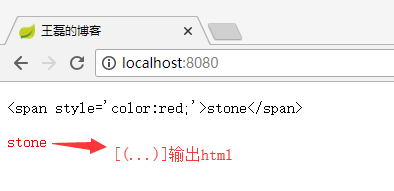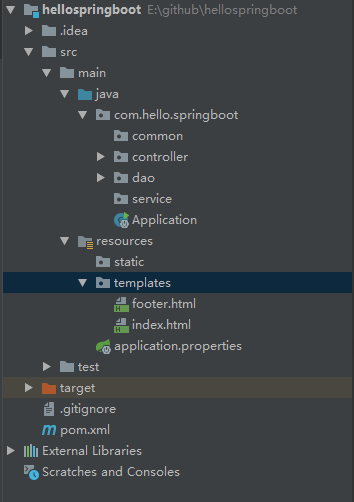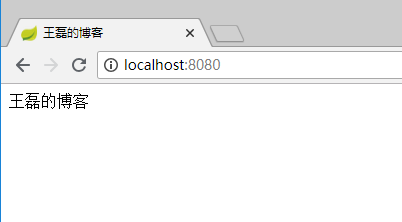Spring Boot 最佳實踐(四)模板引擎Thymeleaf集成
一、Thymeleaf介紹
Thymeleaf是一種Java XML / XHTML / HTML5模板引擎,可以在Web和非Web環境中使用。它更適合在基於MVC的Web應用程序的視圖層提供XHTML / HTML5,但即使在脫機環境中,它也可以處理任何XML文件。它提供了完整的Spring Framework集成。
關於Spring推薦Thymeleaf的這種說法,我在Spring官方文檔並沒有看到具體的說明,只是在和JSP比較的時候,說了JSP和Thymeleaf對比JSP的一些不足,而Thymeleaf只是作為其他模板引擎的一種代表。
作為一款優秀的模板引擎,除了易用性、活躍的社區、健康快速的發展外,還有非常重要的一點就是性能了,那Thymeleaf 3 和 FreeMaker 的性能對比是怎麽樣的,後續文章會陸續更新。
二、Thymeleaf基礎使用
Thymeleaf的使用是由兩部分組成的:標簽 + 表達式,標簽是Thymeleaf的語法結構,而表達式就是語法裏的內容實現。
通過標簽 + 表達式,讓數據和模板結合,最終轉換成html代碼,返回給用戶。
Thymeleaf基礎使用分為三部分:
- 標簽使用
- 表達式使用
- 設置IDEA 對 Thymeleaf 代碼補全
1.標簽使用
1.1 th:text 基礎信息輸出
HTML代碼:
<!DOCTYPE html> <html xmlns="http://www.w3.org/1999/xhtml" xmlns:th="http://www.thymeleaf.org"> <head> <meta charset="UTF-8"> <title>王磊的博客</title> </head> <body> <span th:text="${name}"></span> </body> </html>
Java代碼:
@RequestMapping("/")
public ModelAndView index() {
ModelAndView modelAndView = new ModelAndView("/index");
modelAndView.addObject("name", "老王");
return modelAndView;
}最終效果: 老王
1.2 th:utext html內容輸出
使用"th:text"是對內容的原樣輸出,使用“th:utext”可以進行html標簽輸出。
Java代碼:
@RequestMapping("/eat")
public ModelAndView eat() {
ModelAndView modelAndView = new ModelAndView("/cat");
modelAndView.addObject("data", "<span style='color:red'>老王是吃貨</span>");
return modelAndView;
}HTML代碼:
<h4 th:text="'th:text '+${data}"></h4>
<h4 th:utext="'th:utext '+${data}"></h4>展示效果:
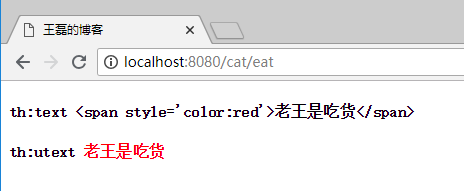
1.3 th:if, th:unless 條件判斷
<span th:if="${age > 18}">
成年
</span>
<span th:unless="${age > 18}">
未成年
</span>th:if為滿足條件的業務處理,th:unless正好相反,是除去的意思。
1.4 th:switch, th:case 多條件判斷
<div th:switch="${age}">
<span th:case="18">18歲</span>
<span th:case="19">19歲</span>
<spa th:case="*">其他</spa>
</div>註意: 默認選項使用th:case="*" 指定。
1.5 th:each 循環
HTML代碼:
<div th:each="name,item:${names}">
<span th:text="${item.count}"></span>
<span th:text="${name}"></span>
</div>Java代碼:
@RequestMapping("/")
public ModelAndView index() {
ArrayList<String> names = new ArrayList<>();
names.add("java");
names.add("golang");
names.add("nodejs");
ModelAndView modelAndView = new ModelAndView("/index");
modelAndView.addObject("names",names);
return modelAndView;
}訪問效果如下:

其中item為每行的詳細值,key值如下:
- index 下標,從0開始
- count 第x個,從1開始
- size 這個集合的大小
- current 當前行的值
1.6 th:fragment、th:insert、th:replace、th:include 代碼片段復用
- th:fragment標簽是聲明代碼片段,用於解決代碼復用的問題,好比Java程序寫的公用代碼一樣,每個需要的地方都可以直接調用;
- th:insert 引用fragment的代碼,保留自己的主標簽;
- th:replace 引用fragment的代碼,不保留自己的主標簽;
- th:include 使用類似th:replace,Thymeleaf3.0之後不推薦使用;
footer.html頁面代碼:
<!DOCTYPE html>
<html xmlns="http://www.w3.org/1999/xhtml"
xmlns:th="http://www.thymeleaf.org">
<head>
<meta charset="UTF-8">
<title>王磊的博客</title>
</head>
<body>
<div th:fragment="copyright">
? 著作權歸 老王 所有
</div>
<div th:fragment="about">
關於
</div>
<div th:fragment="links">
CCTV
</div>
</body>
</html>聲明了兩個代碼片段,copyright和about。
cat.html頁面代碼:
<!DOCTYPE html>
<html xmlns="http://www.w3.org/1999/xhtml"
xmlns:th="http://www.thymeleaf.org">
<head>
<meta charset="UTF-8">
<title>王磊的博客</title>
</head>
<body>
<div th:replace="footer :: copyright"></div>
<div th:insert="footer :: about"></div>
<div th:include="footer :: links"></div>
</body>
</html>其中第一個div引用了footer.html 的 copyright 代碼片段,第二個div引用了 footer.html 的 about 代碼片段。
雙冒號的理解: 其中使用“::”雙冒號來完成對頁面片段的引用,有點像php裏面的語法,使用雙冒號來表示對類的靜態屬性和方法進行直接引用。
執行效果如下圖:
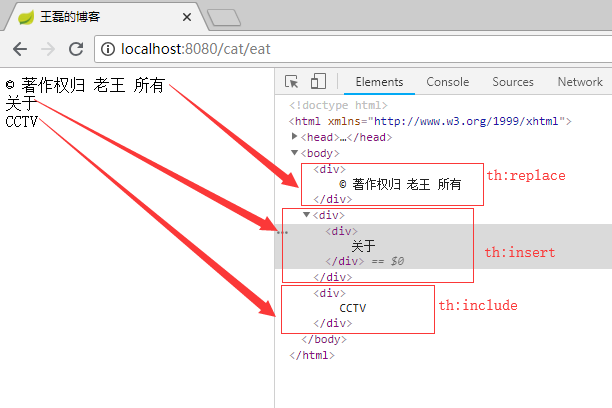
總結: 可以很清晰的看出th:insert、th:replace、th:include之間的區別,在於是否保留自己的主標簽,th:include 在3.0之後已經不推薦使用了,可以使用th:replace標簽替代。
提高班——fragment代碼傳參
使用fragment我們是可以在html代碼中傳參的,比如我們定義了一個top.html其中有一個“歡迎XXX”的提示,而這個人名XXX就是需要動態傳遞的,這樣我們可以最大程度的完成代碼的復用,這個時候就是一個很好的使用場景,我們需要這樣做。
頁面main.html代碼:
<!DOCTYPE html>
<html xmlns="http://www.w3.org/1999/xhtml"
xmlns:th="http://www.thymeleaf.org"
>
<head>
<meta charset="UTF-8">
<title>王磊的博客</title>
</head>
<body>
<div th:replace="footer :: webcome('老王')"></div>
</body>
</html>頁面top.html
<!DOCTYPE html>
<html xmlns="http://www.w3.org/1999/xhtml"
xmlns:th="http://www.thymeleaf.org"
>
<head>
<meta charset="UTF-8">
<title>王磊的博客</title>
</head>
<body>
<div th:fragment="webcome(about)">
<span th:text="'歡迎:'+${about}"></span>
</div>
</body>
</html>最終的效果:
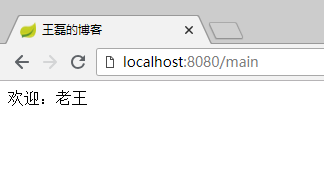
1.7 th:with 定義局部變量
頁面代碼:
<!DOCTYPE html>
<html xmlns="http://www.w3.org/1999/xhtml"
xmlns:th="http://www.thymeleaf.org"
>
<head>
<meta charset="UTF-8">
<title>王磊的博客</title>
</head>
<body>
<div th:with="sum=4-2">
<span th:text="${sum}"></span>
</div>
</body>
</html>頁面輸出結果:2
1.8 th:remove 刪除標簽
th:remove用於html代碼的刪除,th:remove值有五個:
- all 刪除本段所有代碼
- body 刪除主標簽內的所有元素
- tag 刪除主標簽,保留主標簽所有的元素
- all-but-first 保留主標簽和第一個元素,其他全部刪除
- none 不刪除任何標簽
示例index.html代碼如下:
<!DOCTYPE html>
<html xmlns="http://www.w3.org/1999/xhtml"
xmlns:th="http://www.thymeleaf.org">
<head>
<meta charset="UTF-8">
<title>王磊的博客</title>
</head>
<body>
<div id="all" th:remove="all">
<span>all</span>
<span>1</span>
</div>
<div id="body" th:remove="body">
<span>body</span>
<span>2</span>
</div>
<div id="tag" th:remove="tag">
<span>tag</span>
<span>3</span>
</div>
<div id="all-but-first" th:remove="all-but-first">
<span>all-but-first</span>
<span>4</span>
</div>
<div id="none" th:remove="none">
<span>none</span>
<span>5</span>
</div>
</body>
</html>最終展示效果如下:
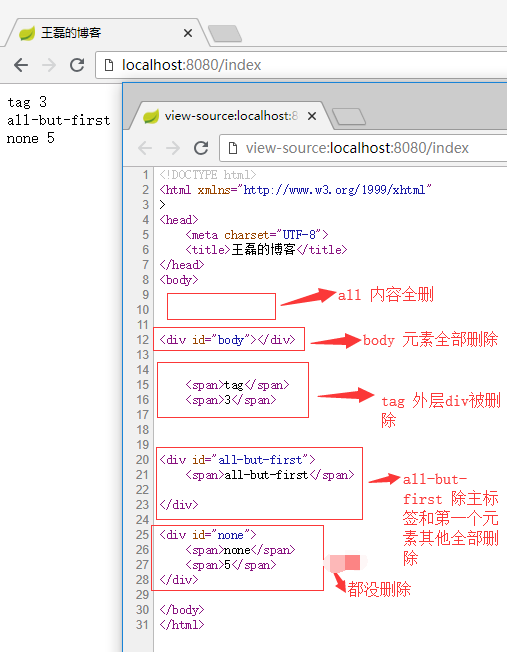
1.9 其他標簽
- th:style 定義樣式
<div th:style="‘color:‘+${skinColor}"> - th:onclick 點擊事件
<input type="button" value=" Click " th:onclick="‘onsub()‘"> - th:href 賦值屬性href
<a th:href="${myhref}"></a> - th:value 賦值屬性value
<input th:value="${user.name}" /> - th:src 賦值src
<img th:src="${img}" /> - th:action 賦值屬性action
<form th:action="@{/suburl}"> - th:id 賦值屬性id
<form id="${fromid}"> - th:attr 定義多個屬性
<img th:attr="src=@{/img/stone.jpg},alt=${alt}" /> - th:object 定義一個對象
<div th:object="${user}"> - ...
2.表達式使用
2.1 表達式概要
2.1.1 簡單表達式
變量表達式:${...}
選擇變量表達式:*{...}
消息表達式:#{...}
鏈接表達式:@{...}
片段表達:~{...}
2.1.2 數據的類型
文字:‘one text‘, ‘Another one!‘,…
數字文字:0, 34, 3.0, 12.3,…
布爾文字:true, false
NULL文字:null
文字標記:one, sometext, main,…
2.1.3 文本操作
字符串拼接:+
字面替換:|The name is ${name}|
2.1.4 算術運算
二進制運算符:+, -, *, /, %
減號(一元運算符):-
2.1.5 布爾運算
二進制運算符:and, or
布爾否定(一元運算符):!, false
2.1.6 條件運算符
比較值:>, <, >=, <=
相等判斷: ==, !=
2.1.7 條件判斷
如果-然後:(if) ? (then)
如果-然後-否則:(if) ? (then) : (else)
違約:(value) ?: (defaultvalue)
所有以上這些表達式都可以組合和嵌套,例如:
‘User is of type ‘ + (${user.isAdmin()} ? ‘Administrator‘ : (${user.type} ?: ‘Unknown‘))
2.2 表達式使用實例
2.2.1 變量表達式 ${...}
變量表達式的使用,我們前面的代碼已經見到了,$是我們平常開發中最常用的表達式,用於把後臺Java類的動態數據,映射到頁面,例如:
Java代碼:
public ModelAndView index() {
ModelAndView modelAndView = new ModelAndView("/cat");
modelAndView.addObject("data", "我是老王");
return modelAndView;
}HTML代碼:
<!DOCTYPE html>
<html xmlns="http://www.w3.org/1999/xhtml"
xmlns:th="http://www.thymeleaf.org">
<head>
<meta charset="UTF-8">
<title>王磊的博客</title>
</head>
<body>
<span th:text="${data}"></span>
</body>
</html>最終效果:
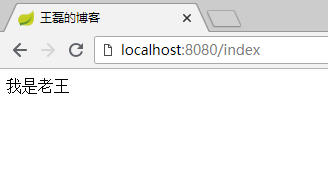
2.2.2 選擇表達式 *{...}
選擇表達式相當於選擇了一個對象,在使用的時候不在需要這個對象的前綴,直接使用屬性的key進行內容展示,代碼如下:
<div th:object="${goods}">
<span th:text="${goods.name}"></span>
<span th:text="*{price}"></span>
<span th:text="${#dates.format(goods.createTime, 'yyyy-MM-dd HH:mm:ss')}"></span>
</div>最終效果:
iMac 7999.0 2018-08-10 14:03:51總結: *{price} = ${goods.price}只是省去了“goods.”前綴,效果都是一樣的。
2.2.3 鏈接表達式 @{...}
用於轉換url,代碼如下:
<a th:href="@{/footer(id=666,name=laowang)}">鏈接</a>最終呈現的效果:
<a href="/footer?id=666&name=laowang">鏈接</a>
鏈接表達式,可以傳遞參數,用逗號分隔。
服務器根相對路徑:@{~/path/to/something}
2.2.4 文本操作
文本操作分為兩個:文本拼加、文本替換
文本拼加:
<span th:text="'我叫'+${name}"></span>文本替換:
文本替換的語法:|內容${tag}|
<span th:text="|我叫${name},是一名開發工程師。|"></span>2.2.5 三元表達式
2.2.6 雙括號作用
<p th:text="${val}">...</p> <p th:text="${{val}}">...</p>結果:
<p>1234567890</p> <p>1,234,567,890</p>2.2.7 嵌入文本標簽
雖然標準的標簽幾乎可以滿足所有的業務場景,但某些情況我們更喜歡直接寫入HTML文本,例如:
<p>Hello, [[${name}]]</p>嵌入文本有兩種寫法“[[...]]”和“[(...)]”,分別的作用就像th:text 和 th:utext 一樣,例如:
<p> [[${name}]] </p> <p> [(${name})] </p>看到的效果是這樣的:
2.3 表達式對象概述
表達式裏面的對象可以幫助我們處理要展示的內容,比如表達式的工具類dates可以格式化時間,這些內置類的熟練使用,可以讓我們使用Thymeleaf的效率提高很多。
2.3.1 表達式基本對象
#ctx: 操作當前上下文.#vars:操作上下文變量.#request: (僅適用於Web項目)HttpServletRequest對象.#response: (僅適用於Web項目)HttpServletResponse對象.#session: (僅適用於Web項目)HttpSession對象.#servletContext: (僅適用於Web項目)ServletContext對象.2.3.2 表達式實用工具類
#execInfo: 操作模板的工具類,包含了一些模板信息,比如:${#execInfo.templateName}.#uris: url處理的工具#conversions: methods for executing the configured conversion service (if any).#dates: 方法來源於java.util.Date對象,用於處理時間,比如:格式化.#calendars: 類似於#dates, 但是來自於java.util.Calendar對象.#numbers: 用於格式化數字.#strings: methods forStringobjects: contains, startsWith, prepending/appending, etc.#objects: 普通的object對象方法.#bools: 判斷bool類型的工具.#arrays: 數組操作工具.#lists: 列表操作數據.#sets: Set操作工具.#maps: Map操作工具.#aggregates: 操作數組或集合的工具.每個類中的具體方法,點擊查看:https://www.thymeleaf.org/doc/tutorials/3.0/usingthymeleaf.html#appendix-b-expression-utility-objects
3.IDEA設置Thymeleaf自動補全
先上效果圖:
IDEA默認是開啟了Thymeleaf 插件支持的,如果不放心需要驗證,請訪問:https://www.jetbrains.com/help/idea/2018.2/thymeleaf.html
但僅僅是配置上面的效果,依然是無法正常使用的,原因是你要在html中聲明 Thymeleaf 命名空間
xmlns:th="http://www.thymeleaf.org",完整代碼如下:<!DOCTYPE html> <html xmlns="http://www.w3.org/1999/xhtml" xmlns:th="http://www.thymeleaf.org"> <head> <meta charset="UTF-8"> <title>Title</title> </head> <body> <h2 th:text="${hi}"></h2> </body> </html>其中關鍵的代碼是:
xmlns:th="http://www.thymeleaf.org"
這樣當你在代碼輸入“th:”的時候就會看到 Thymeleaf 的所有標簽了。
三、Spring Boot 集成 Thymeleaf
3.1 開發環境
- Spring Boot 2.0.4
- Thymeleaf 3.0.9
- Jdk 8
- Windows 10
- IDEA 2018.2
在正式集成Thymeleaf引擎之前,先來看下目錄結構如圖:
3.2 Spring MVC目錄結構
除去包名,我們來解釋一下這些目錄代表的含義:
- common 通用公共類
- controller 控制器類
- dao 數據交互類
- service 業務邏輯處理類
- Application.java 啟動文件
- resources 靜態文件存儲文件夾
- resources/templates 所有的Thymeleaf目錄存放目錄
- resources/application.properties 全局配置類
- pom.xml Maven 配置文件
3.3 Spring Boot 集成 Thymeleaf 分為四步:
- pom.xml 添加 Thymeleaf 模板引擎
- application.properties 配置 Thymeleaf 信息
- 創建controller類,編寫代碼
- 創建模板,編寫html代碼
接下來我們具體分別來看具體的步驟。
3.3.1 pom.xml 添加 Thymeleaf 模板引擎
<!--thymeleaf模板--> <dependency> <groupId>org.springframework.boot</groupId> <artifactId>spring-boot-starter-thymeleaf</artifactId> </dependency>3.3.2 application.properties 配置 Thymeleaf 信息
# 啟用緩存:建議生產開啟 spring.thymeleaf.cache=false # 建議模版是否存在 spring.thymeleaf.check-template-location=true # Content-Type 值 spring.thymeleaf.servlet.content-type=text/html # 是否啟用 spring.thymeleaf.enabled=true # 模版編碼 spring.thymeleaf.encoding=utf-8 # 應該從解析中排除的視圖名稱列表(用逗號分隔) spring.thymeleaf.excluded-view-names= # 模版模式 spring.thymeleaf.mode=HTML5 # 模版存放路徑 spring.thymeleaf.prefix=classpath:/templates/ # 模版後綴 spring.thymeleaf.suffix=.htmlThymeleaf常用配置說明
配置項 類型 默認值 建議值 說明 spring.thymeleaf.enabled bool true 默認 是否啟用 spring.thymeleaf.mode String HTML 默認 模板類型,可以設置為HTML5 spring.thymeleaf.cache bool true 默認 是否啟用緩存,生成環境建議設置為true spring.thymeleaf.prefix String classpath:/templates/ 默認 模版存放路徑 spring.thymeleaf.suffix String .html 默認 模版後綴 spring.thymeleaf.servlet.content-type String text/html 默認 Content-Type 值 spring.thymeleaf.encoding String - utf-8 模版編碼 3.3.3 創建controller類,編寫代碼
我們在controller文件夾創建index.java,代碼如下:
package com.hello.springboot.controller; import org.springframework.stereotype.Controller; import org.springframework.web.bind.annotation.RequestMapping; import org.springframework.web.servlet.ModelAndView; @Controller @RequestMapping("/") public class Index { @RequestMapping("/") public ModelAndView index() { ModelAndView modelAndView = new ModelAndView("/index"); modelAndView.addObject("name", "王磊的博客"); return modelAndView; } }關鍵代碼解讀:
- @ResponseBody註解:如果使用該註解,返回結果會直接輸出,而不是使用模板引擎渲染
- 使用ModelAndView對象,指定視圖名&添加視圖對象
3.3.4 創建模板,編寫html代碼
我們在resources/templates下創建index.html,代碼如下:
<!DOCTYPE html> <html xmlns="http://www.w3.org/1999/xhtml" xmlns:th="http://www.thymeleaf.org"> <head> <meta charset="UTF-8"> <title>王磊的博客</title> </head> <body> <span th:text="${name}"></span> </body> </html>啟動調試,在瀏覽器輸入:http://localhost:8080/
效果如下:
相關代碼GitHub:https://github.com/vipstone/springboot-example.git
四、參考資料
thymeleaf官方文檔 Thymeleaf :https://www.thymeleaf.org/doc/tutorials/3.0/usingthymeleaf.html
thymeleaf官方文檔 Spring + Thymeleaf :https://www.thymeleaf.org/doc/tutorials/3.0/thymeleafspring.html
Spring Boot 最佳實踐(四)模板引擎Thymeleaf集成

